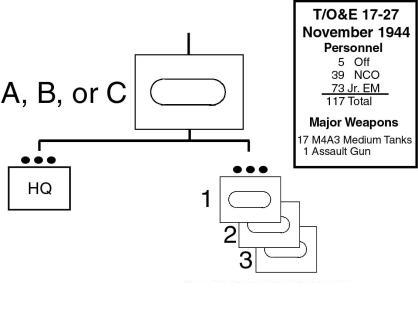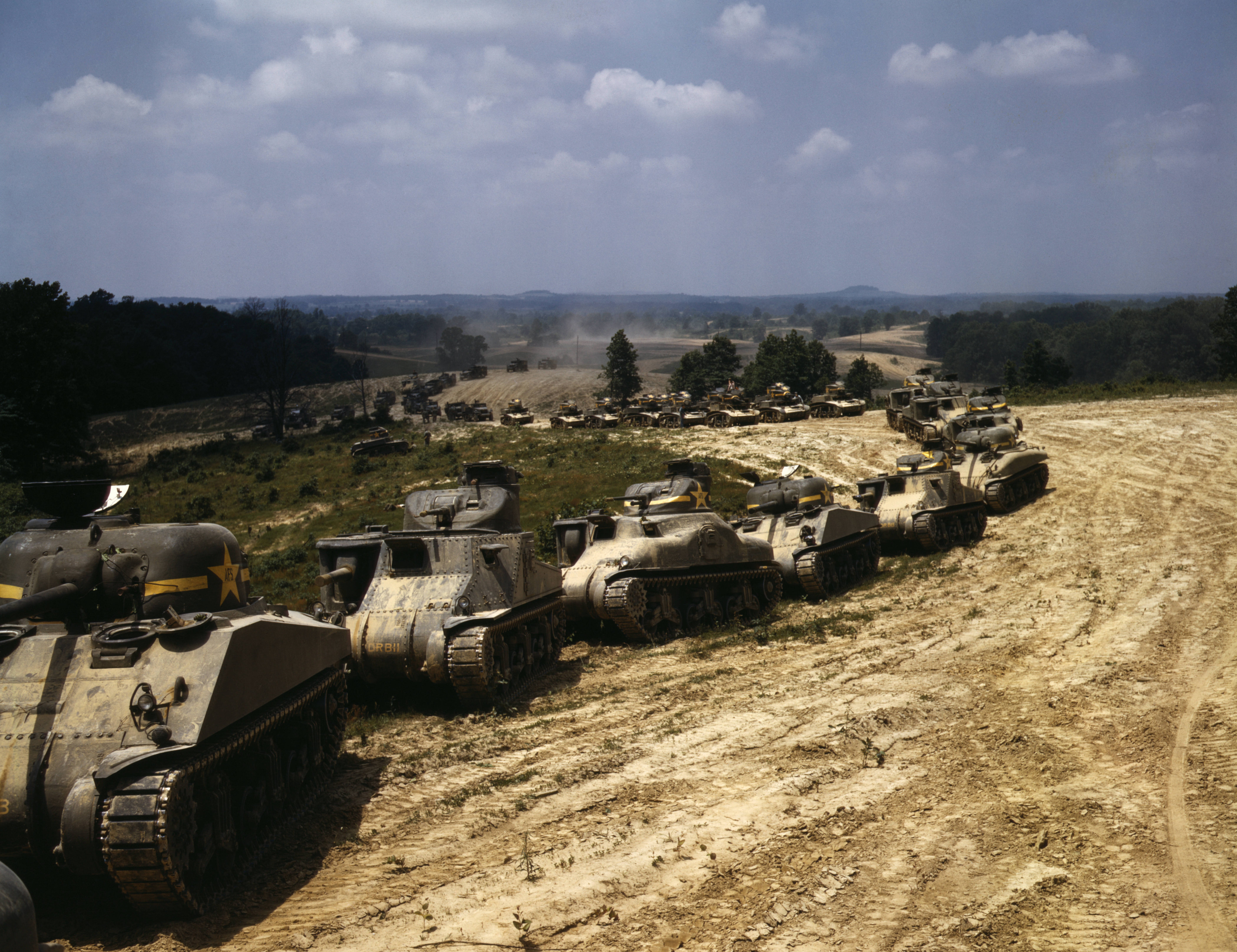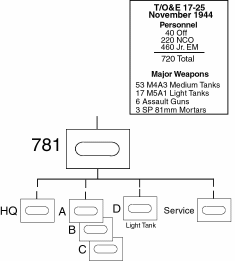The US Army Tank Battalion: How Sherman tanks were deployed
There were two types of tank battalion, the type attached to infantry divisions, as ‘independent’ tank battalions, and the type that were a part of an armored division. They were pretty much the same in organization, if not in how they were used. The life of a tanker could vary wildly from another’s depending on where he got assigned, and the tamest would probably be when they got sent to an armored division.
The Tank Battalion at the start of the war was composed of a much smaller number of vehicles and almost no specialized ones. As the war progressed, the Tank Battalion filled out a lot. They even added a whole service company with a large number of trucks, wreckers, and ARVs. Early in the war, they seem to have relied on the M3half track to fill in for specialty vehicles they didn’t know they needed yet. Once they figured it out in 1943 though, the tank battalion doesn’t seem to have changed much
The Tank Platoon: The Smallest Official Tank Unit
Let’s start with the smallest subunit of the Tank Battalion, The tank platoon.

A Lee tank platoon in North Africa or training in the US would have (1) Officer, (9) NCOs, and (25) enlisted men. Later this would be reduced by five enlisted as the radio operator was dropped. In the US the tanks could be several kinds of Lee, but the units that deployed with M3 Lee tanks for Torch were M3 Lee models with the R975 powering it. The Lee was pretty short-lived in US Service, and the US only took them into combat because there was a shortage of Shermans because of British needs, but once supplies were up, the US removed them, even from training. Many got shipped to the Australians.
A Sherman platoon would be made up of five Sherman tanks, Early in the war, M4s and M4A1 75 tanks, by late 44, they might be a mix of M4 75s, M4A1 75s, M4A3 75w tanks, and M4A1 and M4A3 76 tanks, though some units kept all 75mm tanks. The likely mix would be some M4A3 75 tanks, and M4A3 76 tanks, with some M4A1 76s mixed in with some small hatch M4s and M4A3s. The optimal number of men for a tank platoon is 25, (1) Officer, (9) NCOs, and (15) regular GIs.
These men would be permanently assigned to one of the tanks. In most cases, the tanks were named, and the name reflected the platoons, company designation, for this example we’ll say the platoon belongs to B Company, so all five tanks will be named something starting in B. In the field, the tank would be home, and they would sleep under its tarp next to it, or in it if they were paranoid. The men of a tank platoon would be very close, as they would spend a lot of time with each other.
No. 1 Brenda: M4A3 76w, Platoon leader, Commander by a Lieutenant, Gunner: Corporal, Loader, Driver, and Co-Driver: Jr enlisted. The tank has commander’s radios.
No. 2 Bonnie: M4A3 75w, Commander by a Sargent Gunner: Corporal, Loader, Driver, and Co-Driver: Jr enlisted. Nice new large hatch tank
No. 3 Battlingbitch: M4A1 76w, Commander by a Sargent Gunner: Corporal, Loader, Driver, and Co-Driver: Jr enlisted. This tank has been around since Cobra.
No. 4 Bronco: M4A3 75, Commander by a Staff Sargent Gunner: Corporal, Loader, Driver, and Co-Driver: Jr enlisted. Another small hatch survivor has all updates and C/O radio.
No. 5 BettyW: M4A1 75, Commander by a sergeant, Gunner: Corporal, Loader, Driver, and Co-Driver: Jr enlisted. This tank is a small hatch survivor.
This was as small as the unit was broken down in an Armored Division, at least most of the time. In a separate tank battalion, things would be different. Often a battalion would be assigned to an infantry division for an extended period of time, a few of the divisions the entire war, and they used tanks differently. Sometimes assigning two tanks to a company of infantry, or three. Two tanks were called a Light Section, three a Heavy Section, and that was as small as the tankers wanted to go, but sometimes even single tanks could be working with a couple of platoons of infantry more than their partner tank.

In a separate tank battalion, once assigned to a division for a battle they were often broken down much further. The way they usually did it was each regiment of the division would get a company, and then each battalion of the regiment got a platoon. The HQ platoon would be held in reserve or used to beef up a special combat team. One tank platoon could get to know a battalion of troops very well if they worked together often, and that made for a better team. The longer they stayed assigned together the closer that bond got. Some Army officers even encouraged the exchange of men in bivouac, so infantry and tankers could see how the others lived.
The Tank Company: 17 Shermans Tanks and one Assault Gun or 105 Tank, 5 Officers, 39 NCOs, 73 EM
The next unit up in the Battalion is the Medium Tank Company. An early war US Medium Tank Company was made up of 3 tank platoons containing 5 Lee tanks, and an HQ platoon with 2 more Lee tanks, and 1 jeep and 1, M2 halftrack. They also had an Admin and Mess platoon, with 2, 2 ½ ton trucks, 1, 2 ½ Kitchen truck, and 1 self-propelled 37mm GMC. Last but not least, a Maintenance platoon, made up of 2 M3 Halftracks with winches, and 1 Jeep. To run this outfit, you needed 5 officers, and 144 enlisted men, including 40 NCOs, but it was pretty primitive compared to the later TO&E.
Lee Company, March 1942
HQ Section: (2) Lee Tanks (1) M2 Halftrack and (1) Jeep
Tank Platoons: X(3) Platoons with (5) Lee tanks in each
Admin, Mess, and Supply Section: (2) 2 ½ ton truck (1) 2 ½ Ton Kitchen Truck (1) SP-AT gun
Maintenance Section: (2) M3 Halftracks (1) Jeep
Personnel: (5) Officers, (144) EM
A later war Sherman Company is made up of three Platoons, just like the example we just talked about and a headquarters platoon with two gun tanks and an M4, or M4A3 105 tank or M7 Priest.
The unit has shrunk a little, B Company has 5 Officers, 39 NCOs, and 73 Jr. EMs The HQ Platoon had three tanks, a pair of M4 tanks of any 75/76 variety for the Company Commander and 1st Sargent. The third tank would be an M4A3 105 tank or an M7 priest if the 105 tank was in short supply. The HQ platoon would also have ARV assigned.
It would also have a maintenance section and admin, mess, and supply section attached. This part of the company HQ would have their own trucks and jeeps and would hang back with the ARV and the 105 tank while the fighting was going on. Sometimes the truck would run ammo out to a tank or the ARV would move out to get a tank unstuck or deal with another problem of that type. It would not be uncommon for the men in the HQ platoon not assigned to the combat vehicles to not see the rest of the men in the company for weeks at a time when assigned to a separate tank battalion. When part of an armored division, the companies worked together, and the company commander would lead his company into battle. One of the main differences here are the 105 tanks or M7 Priests and the Tank ARV, that the early company lacked. They had fewer trucks since they were moved into the battalion Service company.
Sherman Company, Late 1943
HQ Section: (2) Sherman Tanks (1) Sherman 105 tank or M7 GMC (1) Jeep
Tank Platoons: X3 (5) Sherman tanks
Maintenance Section: (1) M32 ARV (1) M3 Half Track (1) Jeep
Admin, Mess, and Supply Section: (1) 2 ½ Truck with trailer
Personnel: (5) Officers (112) EM
The Light Tank Company: 17 M5A1 Light Tanks or Chaffee tanks late in the war, 5 Officers, 35 NCOs, and 54 EM
Now is as good a time as any to talk about the light tank company. Early in the war, when the Lee was the main tank, no light tanks were included in the tank battalion TO&E, but they were added by 1943. So from 1943 onward, the tank battalion had four combat companies, three medium tanks, and one of lights. There were also light tank battalions that had all light tank companies.
The light tank company was configured more or less the same way as the medium tank company, three platoons of five tanks, with two HQ platoon tanks. They were used was very different. Even early in the war in North Africa, the light tanks armed with 37mm guns were having trouble. When used in the recon role they had to rely on speed alone to get them out of trouble since the gun wasn’t very useful against anything but the lightest of armor.
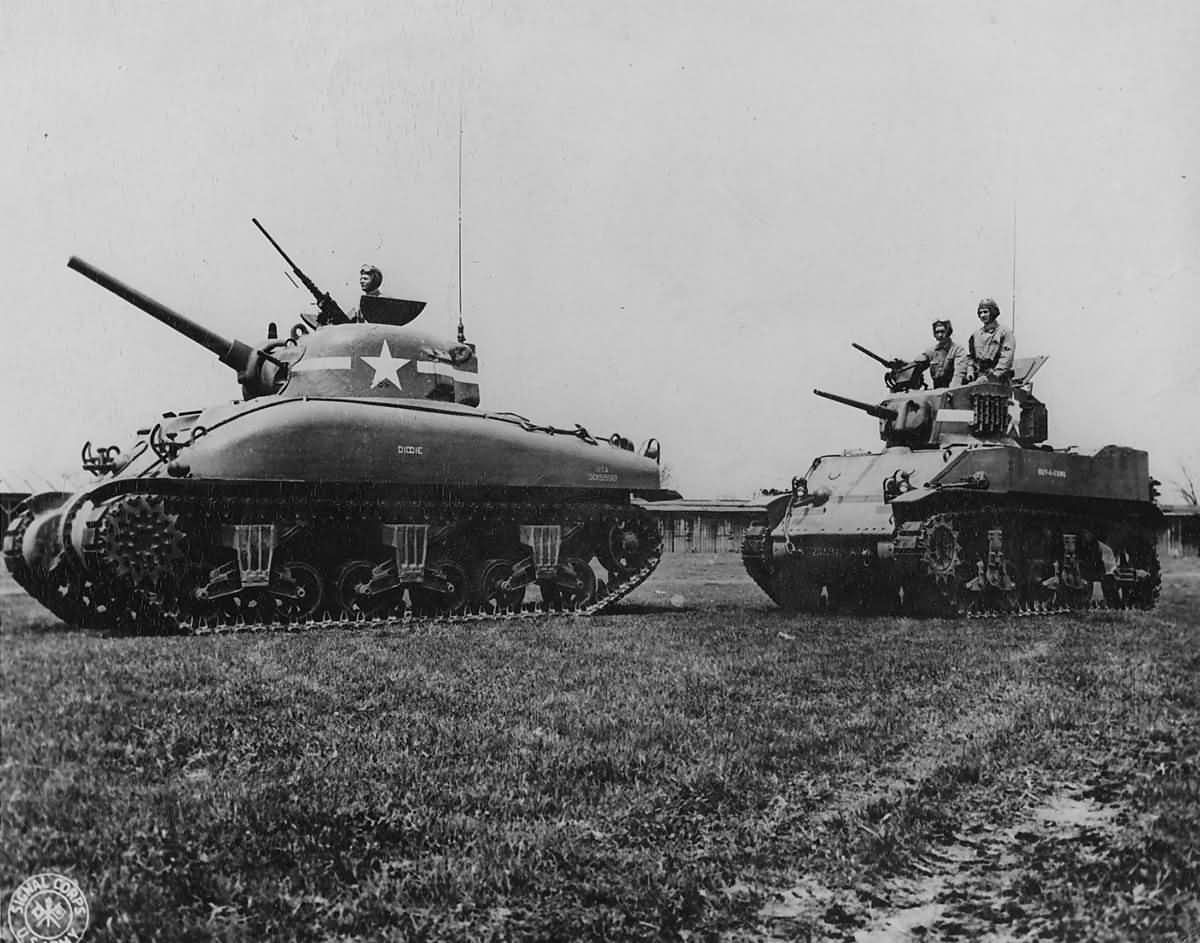
They were fast, and they had lots of machine guns, so they could be used, to a degree against soft targets, so they were used for rear security, messenger duty, and screen flanks and scouting. They would be useful against infantry without good AT weapons. Late in the war when the M24 Chaffee started showing up, these light tank companies really got some teeth, in a very nice little package. The M24 had a 75mm gun that was an improved version of the M3 75mm gun and had a concentric recoil system. Once they got the new light tank they probably took scouting duties back on to some degree, but even the Chaffee was a light tank, and all sorts of AT weapons knocked them out pretty easily.

Light Tank Company late 1943
HQ Section: (2) M5 Light tanks (1) Jeep
Light Tank Platoons: 3X (5) M5 Light Tanks
Maintenance Section: (1) Jeep (1) 1 ARV (1) M3 Halftrack
AM&S Section: (1) 2 ½ ton truck with trailer.
Personnel: (5) Officers (89) EM
The Tank Battalion: 53 Medium tanks, 17 Light Tanks, 6 Assault guns or 105 Shermans, and 3 SP 81mm Mortars, 40 Officers, 220 NCOs, and 460 EM
When you look at the tank battalion and compare the early Lee tank battalion to a later Sherman one, there are some very big differences. This stemmed from the lessons learned fighting these units in North Africa. The size of the battalion grew overall but some units got a little smaller.
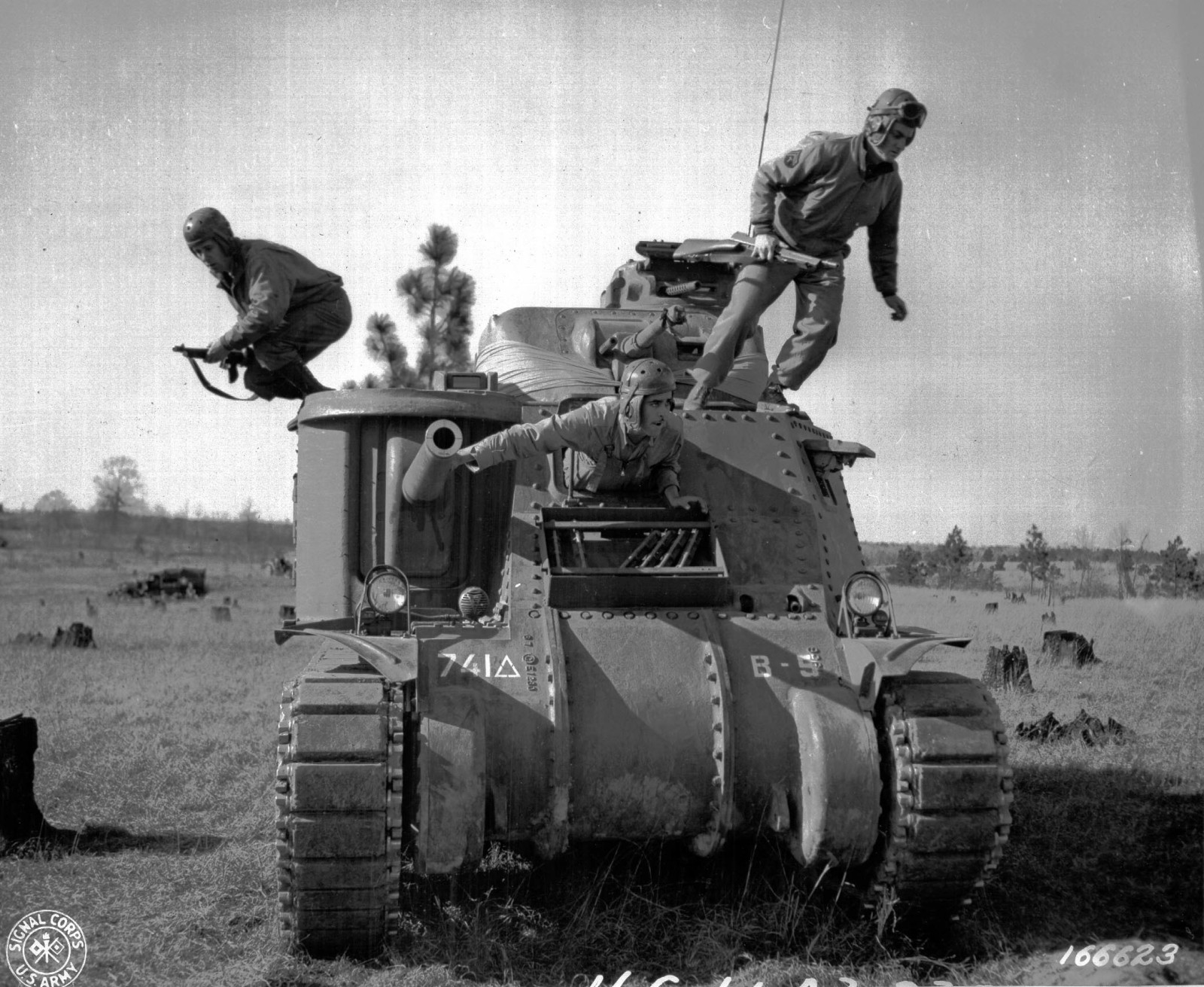
A Tank Battalion in March of 42
Battalion HQ
HQ section: (1) Motorcycle (3) Jeeps (1) M2 Halftrack
Recon Section: (2) Motorcycles (4) Jeeps (1) M2 Halftrack
Tank Section: (3) M3 Lee tanks
Headquarters Company
HQ Section: (2) Jeeps (3) 2 ½ ton trucks (2) M3 Halftracks
Assault Gun Platoon: (3) T30 75mm HMC (3) M3 Halftracks with Trailers
Mortar Platoon: (1) M3 Halftrack (3) M4 81mm Mortar Halftracks
Tank Companies
Company A: (2) Jeeps (17) Lee Tanks (1) SP AT Gun (3) 2 ½ ton Trucks (3) M3 Halftracks
Company B: (2) Jeeps (17) Lee Tanks (1) SP AT Gun (3) 2 ½ ton Trucks (3) M3 Halftracks
Company C: (2) Jeeps (17) Lee Tanks (1) SP AT Gun (3) 2 ½ ton Trucks (3) M3 Halftracks
Total Men: (27) Officers (572) Enlisted
This was not a small unit, but by 1943 it had grown a lot. The new TO&E has a whole new Light tank Company and Service company really fills the unit out.
A Tank Battalion in September of 1943
Battalion HQ Company
Battalion HQ Section: (4) Jeeps (2) M3 Halftracks
Company HQ: (1) M3 Halftrack (1) Jeep
Tank Section: (2) M4 Sherman Tanks
Maintenance Section: (1) M3 Halftrack (1) Jeep
AM&S Section: (1) 2 ½ Truck and Trailer
Recon Platoon: (1) M3 Halftrack (5) Jeeps
Mortar Platoon: (3) M4 81mm Mortar Halftracks (1) M3 Halftrack
Assault Gun Platoon: (2) M3 Halftracks (3) M4 105 Shermans (4) Ammo Trailers
Medical Detachment: (2) ¾ ton WC truck (2) M3 Halftracks (1) ¾ ton ambulance (1) Jeep (4) ¼ ton trailers
Total Men: (15) Officers (154) Enlisted Men
Service Company
HQ Section: (1) ¾ Ton Weapons Carrier Truck
HQ Maintenance Section: (1) Jeep (1) 2 ½ Truck (1) ¼ Ton Trailer
Battalion Maintenance Platoon: (1) Jeep (1) ¾ WC Truck (2) M32 ARV (2) 6 Ton M1 Wrecker (2) 2 ½ Ton Truck (2) ¼ Ton Trailers
Administration, Mess & Supply Section: (1) 2 ½ Ton Truck (1) ¼ Ton Trailer
Administration & Personnel Section: (1) 2 ½ Ton Truck (1) ¼ Ton Trailer
Battalion Supply and Transportation Platoon: (1) Jeep (1) ¾ WC Truck (29) 2 ½ Trucks (13) M10 Ammo Trailers
Total Men: (4) Officers (112) Enlisted
Tank Companies
Medium Tank Company A: (2) Jeeps (17) M4 Shermans (1) M4 105 Sherman (1) M32 ARV (1) M3 Halftrack (1) 2 ½ ton truck (2) ½ trailers
Medium Tank Company B: (2) Jeeps (17) M4 Shermans (1) M4 105 Sherman (1) M32 ARV (1) M3 Halftrack (1) 2 ½ ton truck (2) ½ trailers
Medium Tank Company C: (2) Jeeps (17) M4 Shermans (1) M4 105 Sherman (1) M32 ARV (1) M3 Halftrack (1) 2 ½ ton truck (2) ½ trailers
Light Tank Company D: (2) Jeeps (1) M3 Halftrack (17) M5A1 Tanks (1) M32 ARV (1) 2 ½ Ton Truck (2) ½ Trailers
Battalion Personnel Total
Officers: 39
Enlisted Men: 709

This was the whole kit and caboodle, three medium tank companies, one light, six assault guns, and a service company with three more ARVs. In an AD, all these units would work and train with each other for years. There weren’t that many revisions to the way ADs were configured, so the same units would stay in the same Armored Division for years or the whole war. There would also be a fair amount of competition, not only among the battalions but amongst the companies in the battalions.
They would also have a chance to work with the same Armored Infantry Battalions, and the tank infantry team tactics would become ingrained, and they would have far less trouble working together than many of the independent tank battalions. They also had no issues with supply, since they were part of the division’s supply system.
The independent battalions had a tougher life in many cases. Many got moved around from Infantry Division to Infantry Division, and how well the infantry knew to work with the tanks varied a lot. This could mean the infantry officers may not know the best way to employ armor and would often ask the tankers to things that a tanker knew were suicidal. This sometimes resulted in the tanks being forced into attacking infantry in towns, or even just dug in positions alone, and in the few cases they succeeded, if they were not relieved or supplemented by infantry, they would be pushed off the objective by being overwhelmed by sneaky infantry who can surround tanks without support. They also spent more time on the line than the AD battalions.
They also had to order the supplies, including spare parts through the ID they were attached to, and if the ID supply officers had no experience with this, shortages could take place. The experiences of the independent battalions really varied though. Some worked with the same ID the whole war, others got moved around so much no one got used to them or vice versa, and of course, there was a range of experience in between. Often though, the independents rarely worked in more than platoon size groups, and the only time they would see each other on a regular basis is if they were supporting units in the same fights, or after the battles when the units went into the reserve to rebuild, but in many cases, this is where the tank battalion was detached and sent to another ID in combat.

One final thing to keep in mind about these TO&Es, is they are for an ideal, or full-strength unit. Once in combat, and sometimes even before, because of shortages of items, vehicles, or people, any given tank battalion might be missing several people or vehicles. Once the unit was in combat, and usually, they wouldn’t be deployed unless they were pretty close to their authorized strength, combat losses would be replaced based on the replacements in depots on hand, as would vehicles. Plus, at any given time several tanks, halftracks or trucks, but if the items were not in depots, they went without until they were. The same with men, and once in combat, they would almost never have a full complement of officers and men.
Sources: The 100thwwII.org websites page on the 784st TD, Armored Thunderbolt, US Tank and Tank Destroyer Battalions in the ETO 1944-45 by Zaloga, Yeide’s TD and two separate tank battalion books, Sherman by Hunnicutt, Combat Lessons, The Rank and file, what they do and how they are doing it 1-7, and 9. The Sherman Minutia Site, Son of a Sherman by Stansell and Laughlin, M4 Sherman tank at war by Green, Tanks are a Might Fine Thing by Stout, the Lone Sentry, TM9-731B M4A2, TM9-750M3, TM9-752 M4A3, TM9-754 M4A4, TM9-759 M4A3, TFKSM 17-3-2 Armor in Battle, FM17-12 Tank Gunnery, FM17-15 Combat Practice firing, FM17-30 The Tank Platoon 42, FM17-32 The Tank Company medium and light, FM17-33 The Armored Battalion, FM17-67 Crew Drill and Service of the Piece M4 Series, Another River, another town by Irwin
